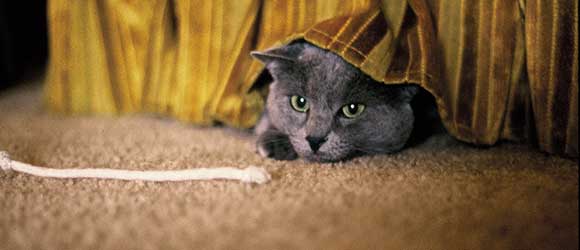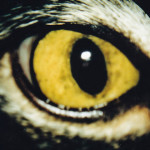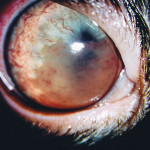
Compared to dogs, cats don’t get many eye diseases. However, one of the most common eye problems in cats is uveitis, and it is usually chronic and can cause blindness and ocular pain. In fact, the three most common reasons for a cat’s eye to be surgically removed (this is called “enucleation”) is ocular trauma (such as a severe cat claw injury to the eye), glaucoma (increased intraocular pressure) secondary to chronic uveitis, and cancer (diffuse iris melanoma). Uveitis in cats can be caused by serious or life-threatening generalized disease in the cat’s body. Therefore, feline uveitis is an important disease to diagnose and treat correctly, to decrease the chances of the eye being blinded and possibly removed, or even of the cat dying from the disease that caused the uveitis.

Normal cat eye
Uveitis is inflammation of the uveal tract, which is the pigmented, vascular part of the eye. This includes the iris (this is the colored part of the eye that forms the pupil), ciliary body, and choroid (see anatomic diagram). The uveal tract (or “uvea”) is all in one piece, and is shaped like a hollow ball with a large slit in it, that fits inside the eyeball. The slit is the cat’s pupil, and the rest of the ball is the iris, ciliary body, and choroid which all “blend” together as a vascular cup. Therefore, if the iris is inflamed, it is likely that the ciliary body and choroid are involved too, either slightly or severely.

Severe Anterior Uveitis. The tannish cloudy spot is a clot of inflammatory debris (fibrin) in the anterior chamber.
Uveitis can have many clinical signs. Here is a list of common ones, that can be mixed and matched in a variety of combinations: squinting, sensitivity to light, third eyelid protrusion, tearing, redness to the white part of the eye, abnormal pupil shape or size, an altered iris color (usually a “muddy” or reddened color compared to the normal color), cloudiness, cataract, and/or enlarged eye if glaucoma is present. Blindness may be apparent, but this is often not noticeable, especially if the fellow eye is visual.
The photo to the left shows severe anterior uveitis. The tannish cloudy area covering the pupil is a clot of inflammatory debris (fibrin) in the anterior chamber.
In approximately 6 out of every 10 cats with uveitis, the cause cannot be identified, even with extensive diagnostic tests. However, when the cause can be identified, it is usually trauma, an infectious disease, or cancer. The most common infectious diseases that can cause uveitis in cats are: Bartonella henselae , feline infectious peritonitis (FIP), Toxoplasma gondii , feline immunodeficiency virus (FIV), feline herpesvirus-1 (FHV-1) and feline leukemia virus (FeLV). The two most common types of cancer that can cause uveitis in cats are lymphoma and also diffuse iris melanoma (DIM). Discussing these various diseases is beyond the scope of this handout. It is important to know that all of these diseases can be life-threatening, with perhaps the exception of feline herpes virus.
The treatment depends on the cause. If cancer is present, the affected eye usually needs to be surgically removed, unless cancer is also present in other parts of the body. If cancer is not present, anti-inflammatory medication is usually prescribed for topical use and sometimes oral use. It is important for the veterinarian to determine if glaucoma is present as a complication of uveitis, as this MUST be treated if it present. It is also a good idea to support the immune system with supplementation, such as mixing 1/2 capsule of Imuno-2865 in the food on a daily basis). Many veterinarian general practitioners do not have an instrument (called a tonometer) to measure the intraocular pressure. If this is the case with your doctor, referral to a veterinary ophthalmologist is highly recommended. If glaucoma is present and the elevated intraocular pressure is not controlled, the eye will become blind and painful (link to glaucoma article) and will then need to be surgically removed. The pain is a “headache” type of discomfort that is NOT obvious to the owner.
Follow your doctor’s treatment instructions. Your doctor may recommend referral of your cat to a board certified veterinary ophthalmologist if the uveitis is not controlled, the cause is unknown, or if glaucoma is suspected or is present. It is important to understand that even with the BEST treatment care of your cat, the uveitis might not be controlled and glaucoma can occur. Also, it is important to know that uveitis in cats is usually a LIFETIME disease that requires LIFETIME treatment and care by an ophthalmologist.